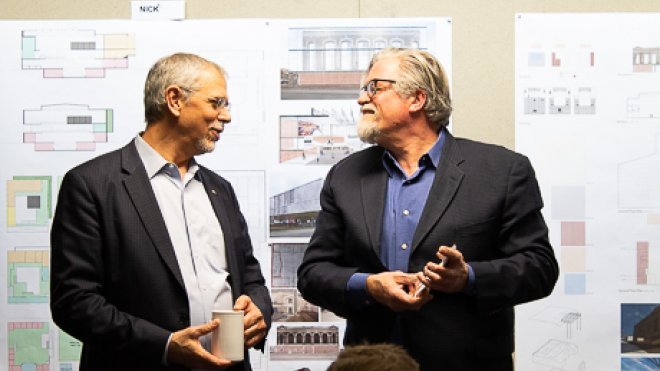Building a Better World with Carl Elefante
2018 President of the American Institute of Architects (AIA) Carl Elefante visited RWU to share his thoughts on sustainable architecture and historic preservation

BRISTOL, R.I. – Carl Elefante, 2018 president of the AIA, spoke at an evening event on March 28th and provided mentorship to an architecture studio class on the 29th. Elefante believes students in the School of Architecture, Art and Historic Preservation (SAAHP) are at the forefront of finding solutions to society's most pressing issues. Affordable housing, healthcare, and climate change, are the major challenges that future architects and preservationists confront. RWU News sat down with Elefante, famous for his quote, “the greenest building is one that’s already built,” to learn his perspective on this field’s potential to shape the future.
What is the main focus of your work?
For the last 25 years, I’ve been focused on helping to define the intersection of sustainable design and historic preservation – how the natural environment and the built environment inform each other.
How and when did you first become interested in sustainable design and historical preservation?
When I was in architecture school 50 years ago in New York City, the first Earth Day happened. Also, the historic preservation movement was beginning, with the demolition of Penn Station. Everybody was saying ‘what are you doing, tearing down the most beloved building in the city?” I wouldn’t say as an architecture student I really got involved in either one, but then 20 years later I’m looking back at my career going, ‘oh, my God! What are the things that really drove my career?’ Well, they were historic preservation and environmental design issues. That was in the atmosphere! And it sent me down a path that completely set the direction of my life.
What is it like being the President of the American Institute of Architects?
It’s been just an incredible experience going around the country meeting thousands of people. It also literally got me out and engaged in what is going on in this very interesting moment in history. We’re at the point where the 21st century is hitting its stride and we’re getting a feeling for how it’s very different from the 20th century. The needs and aspirations are very different from what they were even 50 years ago. I have the opportunity to offer that perspective to help people who are at the beginnings of their careers see and focus on the unique set of circumstances they’re facing.
What role do architects and historic preservationists play in shaping society?
The world of the 21st century is the urban world. The UN estimates that by the end of the century, nearly 9/10 people will live in cities, so the urban environment that we as architects are involved in designing will shape what people do. That’s historic. It’s the first time in a two-million-year history that our cities are literally going to shape the destiny of humankind. That’s a big job description.
What are some of the biggest challenges that future architects and historic preservationists will address in their careers?
We’ve created this amazing modern world with this incredible energy that came after World War II. With it came huge problems. Affordable housing and healthcare are issues absolutely everywhere in this country. There are all these problems that we need to figure out how to solve and there are design influences. We can make the world better. We can create buildings where people are active, create cities where people can walk down the street.
Climate change is a lens for all of this. The atmospheric chemistry has changed. We don’t want it too hot to grow corn. We don’t want the oceans 130 feet higher than they are now. Providence would not exist. It’s likely that we’re going to get to that point before we turn off the carbon spigot and we don’t want that world. Every coastal city would be gone. We’re all in this hot, flat, crowded earth. Let’s design the places that are going to cool it down.
What advice do you have for SAAHP students who are designing and building towards a more sustainable future?
It’s really easy to just get stopped in your tracks by the problems. Recognize that human progress happens because people work together to progress. There’s nothing that’s not solvable here. As we work together and get a diversity of perspectives, we can solve problems where we’re getting peace by working on justice. Architects learn how to do all that. They are being prepared with the disciplines of how to bring high level technical knowledge together with collaborative skills. That’s exactly what our profession needs and what the society around us needs.